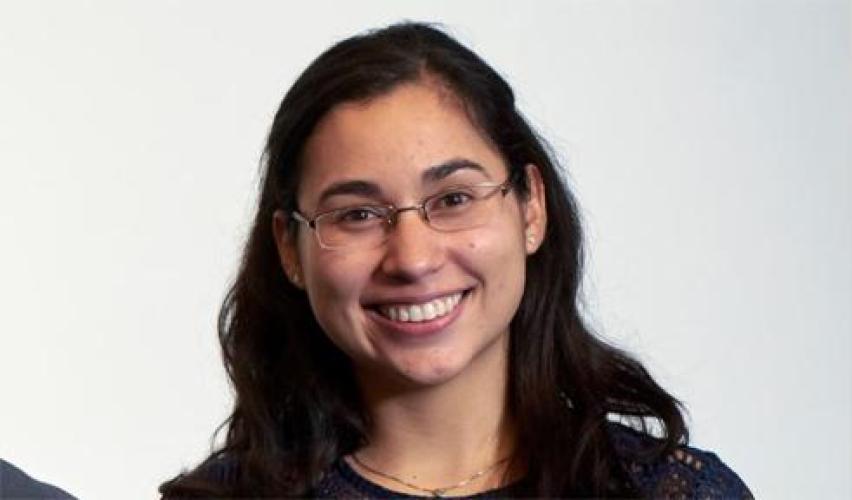
EBI postdoctoral fellow awarded fellowship in aging research

Ohio University alumna and Edison Biotechnology Institute (EBI) postdoctoral researcher Silvana Duran-Ortiz was awarded the 2022 Glenn Foundation for Medical Research Postdoctoral Fellowship in Aging Research.
The $60,000 fellowship supports individuals studying basic mechanisms of aging and this year was only given to nine people. Duran-Ortiz is the only fellow to receive this award in the state of Ohio and is one of two individuals from the Midwest to receive it.
Duran-Ortiz, who is originally from Medellin, Colombia, has been working in the lab of EBI Director John Kopchick, Ph.D., alongside him, EBI Professor and Associate Investigator Edward List, Ph.D., and Associate Dean of Research and Innovation and Professor of Biomedical Sciences Darlene Berryman, Ph.D, focusing on finding ways in which individuals can not only live longer but healthier.
“To me, the fellowship is not only an affirmation of my research findings thus far but also an immense impetus to continue pursuing my goals as a scientist in the field of aging,” Duran-Ortiz said.
Her research proposal titled, “Determining the healthspan and senescent cell and DNA damage response status in long-lived mice with germline and adult-onset growth hormone receptor disruption,” expands on previous research that shows that congenital decrease in growth hormone (GH) action in mice is associated with lifespan extension and with several improved markers of healthspan, including improved insulin sensitivity, resistance to diabetes and cancer, and a slower neuromuscular decline, together making inhibition of GH receptor (GHR) a promising pharmacological intervention to extend healthy aging.
Duran-Ortiz is working on this by switching off the GH axis at multiple ages in mice and recently reported that even at an adult age, GHR inhibition allows significant extension of lifespan in female mice and improves several metabolic markers of healthspan in male and female mice.
“During my Ph.D. studies I realized that aging is the primary driver of many diseases and over time, I became convinced that if we can find and decipher the covert mechanisms and molecular drivers of aging and target them, we can not only extend peoples’ lives, but also improve their quality of life,” Duran-Ortiz said. “I want to continue my career by understanding the basic biology of aging. Thus, instead of honing in on one disease, I want to direct my efforts towards targeting the ‘mechanisms of aging,’ thereby tackling multiple diseases simultaneously.”
She completed her Ph.D. work under the guidance of Kopchick and her M.S. degree under Berryman and was able to design experiments to answer the question of how growth hormone reduction late in life can provide lifespan and healthspan extension.
Currently, she is working on answering this same question by reducing growth hormone action at multiple ages in mice and, through the fellowship, will have the opportunity to evaluate the frailty and healthspan status, the underlying molecular mechanisms responsible for lifespan extension in these mice, and clarify the nature of the gerotherapeutic effects of suppressing growth hormone action in adulthood.
“We are very proud of Silvana for receiving this fellowship after all the work she has put into our group and into this research,” Kopchick said. “This is a very prestigious fellowship that will help prepare and further her as she goes into the field of aging, and we are excited she has been acknowledged in this way for all the work she’s done. This is quite an honor for her, our research group and Ohio University.”
Recipients of the fellowship are determined based on qualifications of the applicant, quality of the proposed research, proposed career development plan, training opportunities for the applicant, excellence of the research environment, likelihood that the applicant will pursue a career in aging research and mentor’s strength and qualifications to guide the applicant’s research and career planning.
“I am extremely grateful to Dr. Kopchick, Dr. List, and Dr. Berryman for all the help and support they’ve provided me,” Duran-Ortiz said. “I would not have been able to receive this fellowship or further my research without them.”
The Glenn Foundation for Medical Research (GFMR), in partnership with the American Federation for Aging Research (AFAR), created the Glenn Foundation for Medical Research Postdoctoral Fellowships in Aging Research to encourage and further the careers of postdoctoral fellows who are conducting research in the basic biology of aging, as well as translating advances in basic research from the laboratory to the clinic.
According to Kopchick, this fellowship and the work Duran-Ortiz is doing are immensely beneficial to the general public and especially older adults since she is studying the basic mechanisms in which tissues age and the susceptibility of developing diseases such as cancer and diabetes.
Her most recent findings published in Aging Cell explains how she found that lifespan and healthspan benefits can be obtained even when growth hormone action is disrupted at a mature adult age. She is also a coauthor on 28 papers, including a recent paper published in Endocrinology on how the disruption of the growth hormone receptor gene in adipose tissue results in increased lifespan in mice.
Duran-Ortiz earned a Ph.D. in Molecular and Cellular Biology from Ohio University's College of Arts and Sciences, as well as a bachelor’s in Biology from CES University in Medellin, Colombia, and a master’s in Nutrition from Ohio University.
In addition to his role as director of EBI, Kopchick is also a Goll-Ohio Eminent Scholar and professor of Molecular Biology. His research focuses on human and animal growth hormone (GH) and the molecular biology of GH in relation to growth, obesity, insulin resistance, diabetes, cancer and aging. He is also the founder of the drug SOMAVERT, a GH antagonist which is used to treat acromegaly, a growth disorder marked by excessive levels of hGH that results in enlargement of the hands and feet, facial disfiguration, multiple organ disorders, and premature death if left untreated.
